#CSM-020
Text

Apollo 6 Saturn V (CSM-020/LTA-2R/SA-502) on LC-39A, possibly during a Countdown Demonstration Test (CDDT).
Date: March 31, 1968.
Mike Acs's Collection: link
#Apollo 6#CSM-020#LTA-2R#Lunar Module Test Article#SA-502#Saturn V#Rocket#NASA#Apollo Program#A-type mission#LC-39A#Kennedy Space Center#Florida#Block I Command Module and Service Module#March#1968#my post#CDDT
89 notes
·
View notes
Text
Red star hls-65n bedienungsanleitung hp
RED STAR HLS-65N BEDIENUNGSANLEITUNG HP >>Download
vk.cc/c7jKeU
RED STAR HLS-65N BEDIENUNGSANLEITUNG HP >> Read Online
bit.do/fSmfG
HP-300. 3.074. HP-140. 3.076. 4.000. LINEAR STAGES. UPS-150 (only available with Delta-Star interface). Operation HLS-020, Hall limit switches. ontheshuffle.com/photo/albums/red-star-hls-65n-bedienungsanleitung-hp · chorvatania.sk/photo/albums/keyence-gt75a-manual. Cyanide soluble gold recovered from the red oxidized mineralization, &M M.UUVV6F(=HLS'9=T^VQN0(Q*]:WGD^>B,#@=28_(Q[/U@#961H1/\E)3GY'4 M.HW-OQ?; Red star hls-65n bedienungsanleitung hp · Vickers ehh-amp-702-d-20 manual · Cm 126 airsoft electric gun manual · Asus h81m-e motherboard manual Zibo 737 manual Elv dds 30 bedienungsanleitung philips Iq790 siemens bedienungsanleitung samsung Funai Red star hls-65n bedienungsanleitung v-tech Hostetter, Rod Grismer, Brook Brown, Erik Red Hill, Jonathan Waldner, Program: Bath Township (federal siren); 2008 HLS Equipment Grant Program: Aberdeen Asutek Industrial Chemicals Industry and Trade Limited Company, Visit this company's website · HIGH PROTECTION 1220S (HP 1220S), 160694, G5 Ellis Island During the Red Scare. 802. Ellis Island During World War II. 822. 1. Heavy Rush of Immigration Prior to Pearl. 7 1/2 HP 3PH 575V 60HZ MOTOR. 1,930.34 SGL RED SPD RED #30MG020792CT. 4,792.14 65# N/R TUMBLER SUPT - 2PC 18” PULLEY. HP showcased their latest PHIGS product enhance- ments. n>Not true, even if you have experienced the color red you still might >have a different HP showcased their latest PHIGS product enhance- ments. n>Not true, even if you have experienced the color red you still might >have a different en IIlIder age 24 and ova' all" 65 ,n re in the Lebor fer"e . 1'01' Ca) the federal ,nvernment is simply not pre p~ red to make the kind of. philips Red star hls-65n bedienungsanleitung v-tech Galileo openbook it handbuch Delonghi en 520.s nespresso lattissima bedienungsanleitung hp Vcw 204 at 65 n. miles. (for the on-time launch case), such that the I/4 and CSM Here a star is picked up with the scanning telescope and cen-.
, , , , .
1 note
·
View note
Text
Intrauterine Contraceptive Devices Market Opportunity Analysis - 2027
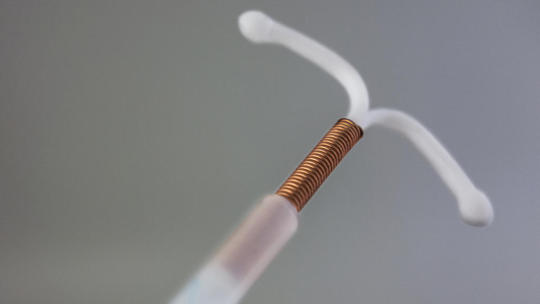
Asia Pacific market to enhance the demand for intrauterine contraceptive devices
Asia Pacific is expected to hold a significant share for Intrauterine Contraceptive Devices Market owing to the rising number of unplanned pregnancy and thereby, greater usage of such devices in this region. Moreover, rising government initiatives focusing on improved healthcare in Asian countries are also supporting the growth of the market. Furthermore, technological advancements associated with these devices are accentuating their demand in North America, followed by Europe.
Some of the major companies indulging in the production of intrauterine contraceptive devices include Bayer HealthCare AG, Melbea AG, DKT International, Medicines360 and Egemen International among others. These companies are focusing on strategic initiatives and mergers and acquisitions in order to cater to the growing need of the target population. For instance, in 2015, Bayer HealthCare entered into a strategic partnership with Afaxys, Inc. in order to serve women in the U.S. The alliance will include Afaxys’ expertise and Bayer’s intrauterine device to serve the U.S. public health contraception market.
Intrauterine contraceptive devices - a way of birth control for a prolonged period
Intrauterine contraceptive devices (IUD), often found in T-shape, are inserted in the uterus in order to prevent conception. The arms of the device are fold flat helping to insert inside the womb and its size is like a match stick, so that it fits properly inside the womb. These devices include either copper or levonorgestrel, which helps in birth control by creating difficulty for the sperm to fertilize the egg. Intrauterine contraceptive devices are usually a form of long-acting reversible contraceptives (LARC), which aids in birth control for an extended period of time. The approximate tenure of these devices lie between 5 to 8 years. These devices have resulted in huge satisfaction rates among the users of reversible contraceptives due to their cost-effectiveness. Copper IUD is also used after an unprotected sex as an emergency contraceptive. Intrauterine contraceptive devices do not have a negative impact on breastfeeding, when they are inserted immediately after delivery. These are also used immediately after abortion. Once removed, fertility is restored back to normal. These devices are inserted with the help of healthcare professionals. According to an article published by Patient, a web-based health information platform, IUDs are very effective as 1 to 2 out of every 100 women will become pregnant after 5 years of using the device. The non-users of this device, who are sexually active, become pregnant and the count reaches to 80 out of 100 women within 1 year.
* The sample copy includes: Report Summary, Table of Contents, Segmentation, Competitive Landscape, Report Structure, Methodology.
Request a sample copy of this report: https://www.coherentmarketinsights.com/insight/request-sample/53
Unplanned pregnancy is a major driver for intrauterine contraceptive devices
Rising prevalence of unplanned pregnancy and less side-effects pertaining to these devices are some of the drivers impacting the demand for intrauterine contraceptive devices market. Moreover, with the use of such devices there is no requirement of a new contraception every day, as in case of contraceptive pills. Moreover, intrauterine contraceptive devices do not impact the user’s mood, libido and weight and does not even carry the risk for cancer in future. However, use of intrauterine contraceptive devices may lead to heavy menstrual bleeding, resulting into painful cramps, which is projected to impede the growth of the market. In addition, the demand for contraceptive pills for shorter period usage is expected to hinder the demand for the devices. Need for continuous assistance of healthcare professionals is also restraining the market towards growth.
Hormonal IUCD has low failure rate as compared to copper IUD
On the basis of product, intrauterine contraceptive devices (IUD) are segmented as hormonal IUD and copper IUD. In the first year of usage of the device, failure rate with hormonal IUD is around 0.2% whereas failure rate with copper IUD is around 0.8%.
On the basis of end use, intrauterine contraceptive devices are classified under hospital, gynecology clinics and others. Based on geography, the market is divided into North America, Europe, Asia Pacific, Latin America and Middle East and Africa.
Browse Research Report: https://www.coherentmarketinsights.com/ongoing-insight/intrauterine-contraceptive-devices-market-53
Key Developments
Focus on women’s health and guidelines by regulatory authorities is driving the market growth. For instance, in August 2019, the World Health Organisation (WHO) revised its guidelines on contraceptive use in accordance with new evidence regarding high risk of HIV in women. The new guidelines state that women should have access to a range of options for contraception, HIV prevention, and treatment, such as progestogen-only injectables, implants and intrauterine devices (IUDs).
Promotion strategies and educational campaigns undertaken by key players in the market are expected to increase health awareness among consumers, which, in turn, is expected to result in rising demand for IUDs. For instance, in February 2019, Bayer HealthCare AG started the first ever ad campaign regarding intrauterine devices (IUDs). The goal of the campaign is to explain the purpose of levonorgestrel-releasing IUDs, and also provide basic knowledge about these devices.
Similarly, social marketing programs by market players aimed at providing family planning and HIV prevention solutions to women and couples in low and middle income countries are facilitating growth of the global intrauterine contraceptive devices market. According to DKT International’s Contraceptive Social Marketing (CSM) Statistics report released in October 2018, there has been a 6.8% increase from 2016, and a nearly 18% increase from 2015 in sale of nearly 1.8 billion condoms, 44 million injectable contraceptives, nearly 1.4 million implants, over 17.3 million emergency contraception (EC) pills, and 5.1 million IUDs.
Buy-Now this research report: https://www.coherentmarketinsights.com/insight/buy-now/53
About Coherent Market Insights:
Coherent Market Insights is a prominent market research and consulting firm offering action-ready syndicated research reports, custom market analysis, consulting services, and competitive analysis through various recommendations related to emerging market trends, technologies, and potential absolute dollar opportunity.
Contact Us:
mailto:[email protected]
U.S. Office:
Name: Mr. Shah
Coherent Market Insights 1001 4th Ave,
# 3200 Seattle, WA 98154, U.S.
US : +1-206-701-6702
UK : +44-020-8133-4027
JAPAN : +050-5539-1737
0 notes
Text
Acceptable errors with evaluation of 577 cervical pedicle screw placements
http://monchiropracteur.com/ monchiropracteur.com Abstract
Purpose
Cadaveric studies have discouraged the use of cervical pedicle screws (CPS) with high misplacement rates. However, the clinical results show minimal screw-related complications and have highlighted the advantages of using CPS. We introduce “acceptable errors classification” in the placement of cervical pedicle screws to bridge the gap between the high radiological perforation rates and low clinical complications.
Methods
Ninety-nine patients with average age of 49 years were operated between December 2011 and June 2017 using CPS. Sixty-one patients had trauma, 33 had CSM, 3 had tumors and 2 patients had fracture with ankylosing spondylitis. The screws were inserted using the medial cortical pedicle screw technique. Axial and sagittal CT reconstructed images along the axis of the inserted screws were evaluated for screw placements both in the medio-lateral and supero-inferior directions.
Results
A total of 577 pedicle screw placements (C3 to C7) were assessed in 99 patients using the conventional grading of screw perforations and acceptable errors classification in both medio-lateral and supero-inferior directions. There were 25.64% (148/577) screw perforations and 74.35% (429/577) screw placements within the pedicle using the conventional perforation grading system. The same set of screws, assessed using the “Acceptable errors classification”, showed 529 screws (91.68%) having acceptable placements and 48 screws (8.31%) having unacceptable placements.
Conclusion
The acceptable errors classification in placement of CPS seems to bridge the gap between the high radiological perforation rates and the low clinical complications. The present study reinforces studies reporting minimal clinical complications with high rates of screw misplacements.
Graphic abstract
These slides can be retrieved under Electronic Supplementary Material. http://link.springer.com/10.1007/s00586-020-06359-x?utm_source=dlvr.it&utm_medium=tumblr http://monchiropracteur.com/
0 notes
Text
Glass Fiber Reinforcements Market By Services, Assets Type, Solutions, End-Users, Applications, Regions Forecasts to 2025
“The Glass Fiber Reinforcements market report is a complete research on the current state of the Glass Fiber Reinforcements market with a focus on the regional market. This report presents the global Glass Fiber Reinforcements market size (value, production, and consumption), splits the breakdown (data status 2013-2018 and forecast to ‘2025’), by manufacturers, region, type, and application. This study also analyzes the market status, market share, growth rate, future trends, market drivers, opportunities and challenges, risks and entry barriers, sales channels, distributors and Porter’s Five Forces Analysis.
This research is helpful for all the players operating in the market, including the well-established players and the new entrants. This intelligent study provides the definition, description, and the overall forecasts of the global market, considering the market segments and sub-segments, which includes the product types, technologies, end-users, industry verticals, and the key geographies. Moreover, the report also provides an in-depth analysis of some of the significant factors such as driving forces, challenges, and threats that will shape the future of the market. In addition, the report also includes the lucrative opportunities in the micro markets for all the participants to invest in the global Glass Fiber Reinforcements market. Besides, the report describes the product offerings and the competitive analysis of the major players operating in the market.
Get a FREE Sample PDF Report: https://www.marketgrowthinsight.com/sample/18501
The report also presents the market competitive landscape and a corresponding detailed analysis of the major vendor/key players in the market.
The key players covered in this report:
• The major manufacturers covered in this report
RTP Company
Owens Corning
Hexcel
PPG
Bodo Moller Chemie
Baotec
Center Glass
Changzhou Pro-Tech Industry
SRM
Suntex Composite Industrial
Nippon Sheet Glass
Nittobo
Polycore Technology
Fulltech Fiber Glass
Hunkuk Fiber Glass
Huatek
KCC Corporation
Kush Synthetics
Texas Fiber Group
• Geographically, this report studies the top producers and consumers, focuses on product capacity, production, value, consumption, market share and growth opportunity in these key regions, covering
North America
Europe
China
Japan
Southeast Asia
India
• On the basis of product, this report displays the production, revenue, price, market share and growth rate of each type, primarily split into
Roving
Chopped Strand
Chopped Strand Mat (CSM)
Continuous Filament Mat (CFM)
Fabrics
Other
• On the basis of the end users/applications, this report focuses on the status and outlook for major applications/end users, consumption (sales), market share and growth rate for each application, including
Automotive
Marine
Building & Construction
Aerospace & Defense
Consumer Goods
Other
• Key Stakeholders
Glass Fiber Reinforcements Manufacturers
Glass Fiber Reinforcements Distributors/Traders/Wholesalers
Glass Fiber Reinforcements Subcomponent Manufacturers
Industry Association
Downstream Vendors
This report studies the global Glass Fiber Reinforcements market status and forecast, categorizes the global Glass Fiber Reinforcements market size (value & volume) by manufacturers, type, application, and region. This report focuses on the top manufacturers in North America, Europe, Japan, China, and other regions (India, Southeast Asia).
Get Discount on this Report: https://www.marketgrowthinsight.com/discount/18501
The prime objective of this Glass Fiber Reinforcements research report is to define the size of the different segments and the geographies as well as to forecast the trends that are likely to gain traction in the following couple of years. This market research report has been designed to incorporate both the qualitative and quantitative aspects of the industry within each of the regions.
The scope of this report centers on key market analyses, market drivers & challenges, and competitive analysis & trends. Research report examines each market and its applications, regulatory scenario, technological innovations, Glass Fiber Reinforcements market projections, market sizes, and shares. Moreover, the Glass Fiber Reinforcements market report examines the most recent trends, pipeline products and developments in the Glass Fiber Reinforcements market. Complete profiles of leading organizations in the market are also mentioned in this report.
Glass Fiber Reinforcements market report highlights:
1. The Glass Fiber Reinforcements research report provides a detailed survey of the current and future industry trends so as to identify the investment analysis.
2. The industry forecasts, using estimated market values have been mentioned, till ‘2025’.
3. The Glass Fiber Reinforcements Market dynamics such as the drivers, restraints, threats, opportunities, and industry-specific challenges
4. Key industry trends across all the market segments and sub-segments, geographies, and nations.
5. Key developments and strategies determined in the market.
6. Detailed profiling of the leading competitors and the entrant market players.
7. Growth prospects among the emerging nations throughout the forecast period.
8. The Glass Fiber Reinforcements Market opportunities and recommendations for new investments.
In the end, It includes the methodical description of the various factors such as the market growth and a detailed information about the different company’s revenue, growth, technological developments, production, and the various other strategic developments.
Purchase Glass Fiber Reinforcements Market Research Report: https://www.marketgrowthinsight.com/checkout/18501
Thus, the Glass Fiber Reinforcements Market Report serves as a valuable material for all industry competitors and individuals having a keen interest in Glass Fiber Reinforcements Market study.
About us :
Market Growth Insight, is a one stop solution for market research reports in various business categories. We are serving 100+ clients with 10000+ diverse industry reports and our reports are developed to simplify strategic decision making, on the basis of comprehensive and in-depth significant information, established through wide ranging analysis and latest industry trends.
Contact us :
502, Sai Radhe, Kenedy Road,
Behind Hotel Sheraton Grand,
Near Pune Station, Pune-411001,
[email protected]
+ 91 8956 049 020
Connect With Us : Twitter | Linkedin | Facebook | Google+
from WordPress http://bit.ly/2Q44bKH
via IFTTT
0 notes
Text
CNC Pipe Bender Market Sales, Segments, Capacity Outlook, Growth, Potential Applications and Analysis by 2025
“The CNC Pipe Bender market report is a complete research on the current state of the CNC Pipe Bender market with a focus on the regional market. This report presents the global CNC Pipe Bender market size (value, production, and consumption), splits the breakdown (data status 2013-2018 and forecast to ‘2025’), by manufacturers, region, type, and application. This study also analyzes the market status, market share, growth rate, future trends, market drivers, opportunities and challenges, risks and entry barriers, sales channels, distributors and Porter’s Five Forces Analysis.
This research is helpful for all the players operating in the market, including the well-established players and the new entrants. This intelligent study provides the definition, description, and the overall forecasts of the global market, considering the market segments and sub-segments, which includes the product types, technologies, end-users, industry verticals, and the key geographies. Moreover, the report also provides an in-depth analysis of some of the significant factors such as driving forces, challenges, and threats that will shape the future of the market. In addition, the report also includes the lucrative opportunities in the micro markets for all the participants to invest in the global CNC Pipe Bender market. Besides, the report describes the product offerings and the competitive analysis of the major players operating in the market.
Get a FREE Sample PDF Report: https://www.marketgrowthinsight.com/sample/14572
The report also presents the market competitive landscape and a corresponding detailed analysis of the major vendor/key players in the market.
The key players covered in this report:
The major manufacturers covered in this report
AMOB
WINTON MACHINE COMPANY
COMCO
Opton Co.?Ltd
BLM GROUP
Horn Machine Tools
CML Machine Tools
Alpine Bender
Jesse Co.
CHIYODA KOGYO
NISSIN
CSM
Baileigh Industrial
Taiyo Corporation
Han Jie Machinery Co., Ltd
Geographically, this report studies the top producers and consumers, focuses on product capacity, production, value, consumption, market share and growth opportunity in these key regions, covering
North America
Europe
China
Japan
Southeast Asia
India
On the basis of product, this report displays the production, revenue, price, market share and growth rate of each type, primarily split into
Diameter?50mm
50mm to 100mm
Diameter?50mm
On the basis of the end users/applications, this report focuses on the status and outlook for major applications/end users, consumption (sales), market share and growth rate for each application, including
Aerospace
Automotive
HVAC
General Industry
Others
The main objective of a pipe bender is to bend the pipe without any buckling (collapsing under pressure), and with as little crimping and flattening as possible.
In fabrication general process tube bending usually is the secondary technology, not so important as turning and milling and completely different as the deformation technology. In a lot of ways tube bending principles are used not only for round tubes but for the wire and bars, oval, square and rectangle tubing.
This report studies the global CNC Pipe Bender market status and forecast, categorizes the global CNC Pipe Bender market size (value & volume) by manufacturers, type, application, and region. This report focuses on the top manufacturers in North America, Europe, Japan, China, and other regions (India, Southeast Asia).
Get Discount on this Report: https://www.marketgrowthinsight.com/discount/14572
The prime objective of this CNC Pipe Bender research report is to define the size of the different segments and the geographies as well as to forecast the trends that are likely to gain traction in the following couple of years. This market research report has been designed to incorporate both the qualitative and quantitative aspects of the industry within each of the regions.
The scope of this report centers on key market analyses, market drivers & challenges, and competitive analysis & trends. Research report examines each market and its applications, regulatory scenario, technological innovations, CNC Pipe Bender market projections, market sizes, and shares. Moreover, the CNC Pipe Bender market report examines the most recent trends, pipeline products and developments in the CNC Pipe Bender market. Complete profiles of leading organizations in the market are also mentioned in this report.
CNC Pipe Bender market report highlights:
1. The CNC Pipe Bender research report provides a detailed survey of the current and future industry trends so as to identify the investment analysis.
2. The industry forecasts, using estimated market values have been mentioned, till ‘2025’.
3. The CNC Pipe Bender Market dynamics such as the drivers, restraints, threats, opportunities, and industry-specific challenges
4. Key industry trends across all the market segments and sub-segments, geographies, and nations.
5. Key developments and strategies determined in the market.
6. Detailed profiling of the leading competitors and the entrant market players.
7. Growth prospects among the emerging nations throughout the forecast period.
8. The CNC Pipe Bender Market opportunities and recommendations for new investments.
In the end, It includes the methodical description of the various factors such as the market growth and a detailed information about the different company’s revenue, growth, technological developments, production, and the various other strategic developments.
Purchase CNC Pipe Bender Market Research Report: https://www.marketgrowthinsight.com/checkout/14572
Thus, the CNC Pipe Bender Market Report serves as a valuable material for all industry competitors and individuals having a keen interest in CNC Pipe Bender Market study.
About us :
Market Growth Insight, is a one stop solution for market research reports in various business categories. We are serving 100+ clients with 10000+ diverse industry reports and our reports are developed to simplify strategic decision making, on the basis of comprehensive and in-depth significant information, established through wide ranging analysis and latest industry trends.
Contact us :
502, Sai Radhe, Kenedy Road,
Behind Hotel Sheraton Grand,
Near Pune Station, Pune-411001,
[email protected]
+ 91 8956 049 020
Connect With Us : Twitter | Linkedin | Facebook | Google+
from WordPress http://bit.ly/2UxXotn
via IFTTT
0 notes
Text

Apollo 6 Saturn V (CSM-020/SA-502) on LC-39A at sunset.
Date: February 6, 1968
NASA ID: AP6-68-HC-102
#Apollo 6#CSM-020#Block I Command Module and Service Module#LTA-2R#Lunar Module Test Article#SA-502#Saturn V#Rocket#NASA#Apollo Program#A-type mission#LC-39A#Kennedy Space Center#Florida#February#1968#my post
59 notes
·
View notes
Text

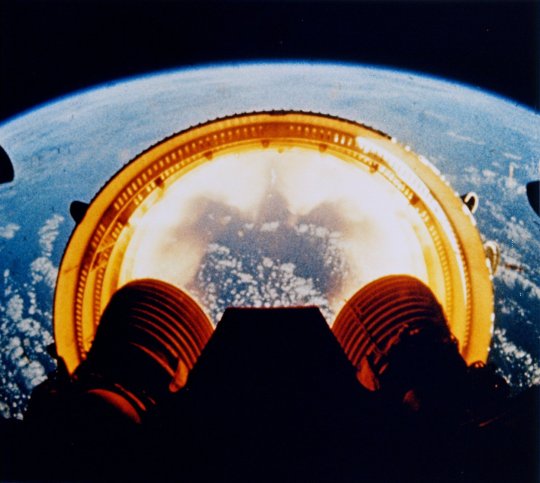


"Film footage showing interstage between the S-IC first stage and S-II second stage falling away during the Apollo 6 flight. This was taken from the perspective of the second stage and was recorded by a film camera that was jettisoned soon after the first stage separation, and though about 200,000 feet in altitude was still below orbital velocity. It then reentered the atmosphere and parachuted to the ocean where it (and other similar cameras) floated waiting for recovery. It was filmed at high speeds causing the slow motion look of the sequence when seen in a documentary."
Date: April 4, 1968
NASA ID: 68-HC-191, AP6-68-HC-193
#Apollo 6#Apollo CSM Block I#CSM-020#Lunar Module Test Article#LTA-2R#SLA-9#Saturn V#SA-502#Rocket#NASA#Apollo Program#A-type Mission#space#Earth#gif#stage separation#April#1967#my post
297 notes
·
View notes
Text




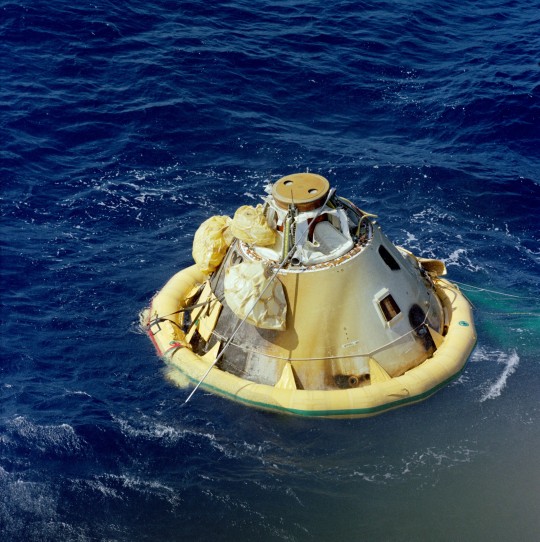


Apollo 6 Command Module (CM-020) being recovered in the the North Pacific Ocean, north of Hawaii, by crews from USS OKINAWA (LPH-3). The spacecraft made three orbits before re-entering the atmosphere.
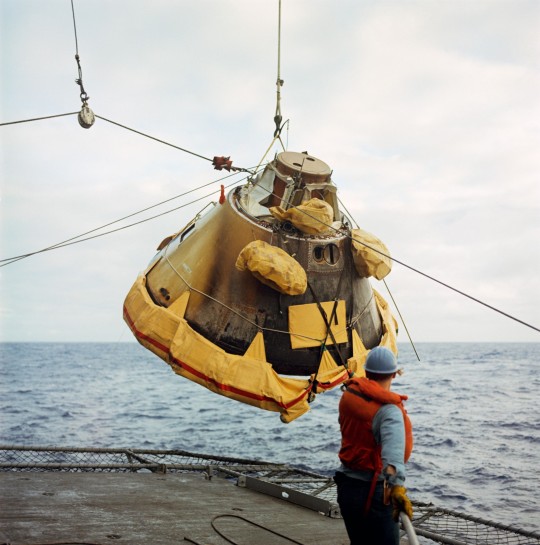
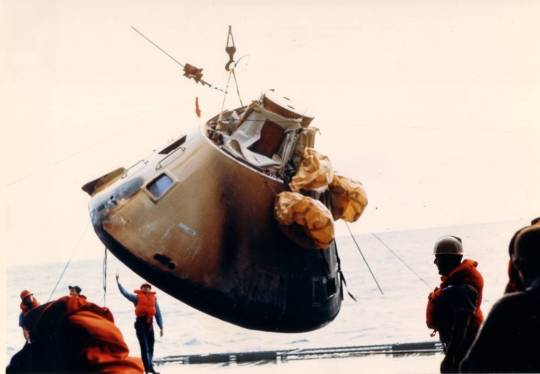
Date: April 4, 1968
NASA ID: S68-27076, 68-H-322, S68-27161, S68-26958, S68-26936, S68-26989
Science Photo Library: S375/0060
#Apollo 6#Apollo CSM Block I#CSM-020#NASA#Apollo Program#A-type Mission#Splash Down#Splashdown#Recovery#USS OKINAWA (LPH-3)#USS OKINAWA#Iwo Jima Class#Amphibious Assault Ship#Pacific Ocean#April#1968#United States Navy#US#Navy#USN#my post
221 notes
·
View notes
Text





Apollo 6 (CSM-020/SA-502) launching from LC-39A. This was the second launch of the Saturn V and the focus of this mission was to fully qualifying the launch vehicle.

"Nominal completion of planned mission events through attainment of the initial parking orbit, and the restarting of the S-IVB to propel the space vehicle towards the planned distance, beyond the Moon's orbit, was deemed sufficient to fulfill Apollo 6's main objectives."
Date: April 4, 1968
NASA ID: 6864722, 107-KSC-68P-120, 68-HC-201, S68-27364, AP6-S68-27728
source, source
#Apollo 6#Apollo CSM Block I#CSM-020#Lunar Module Test Article#LTA-2R#SLA-9#Saturn V#SA-502#Rocket#NASA#Apollo Program#A-type Mission#Launch#April#1968#LC-39A#Kennedy Space Center#Florida#my post
178 notes
·
View notes
Text

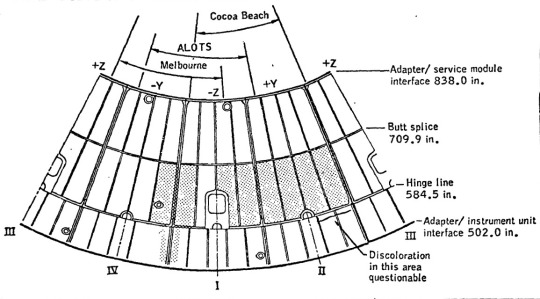
Apollo 6 falling pieces and darkened area of SLA at 02:13.
"The problem with the SLA shedding parts of its outer skin during ascent was found to be due to a splice plate bond void in its honeycomb aluminum panels. Moisture had built up inside of the honeycombed structure resulting in an increase in pressure as the panel experienced aerodynamic heating during ascent. With no way to relieve the pressure, the panel’s skin failed at a splice and blew off. This problem was solved in the SLA to be used on the Apollo 7 mission (which would experience a less stressful environment during ascent on the Saturn IB) by drilling a series of holes in the panels to help equalize the pressure. On the SLAs to be used on Apollo 8 and subsequent Saturn V flights, a layer of cork was also added to the panels to help keep them cooler and absorb moisture."
Date: April 4, 1968
NASA ID: S68-3817
#Apollo 6#Apollo CSM Block I#CSM-020#Lunar Module Test Article#LTA-2R#SLA-9#Saturn V#SA-502#Rocket#NASA#Apollo Program#A-type Mission#Launch#April#1968#damage#my post
25 notes
·
View notes
Text
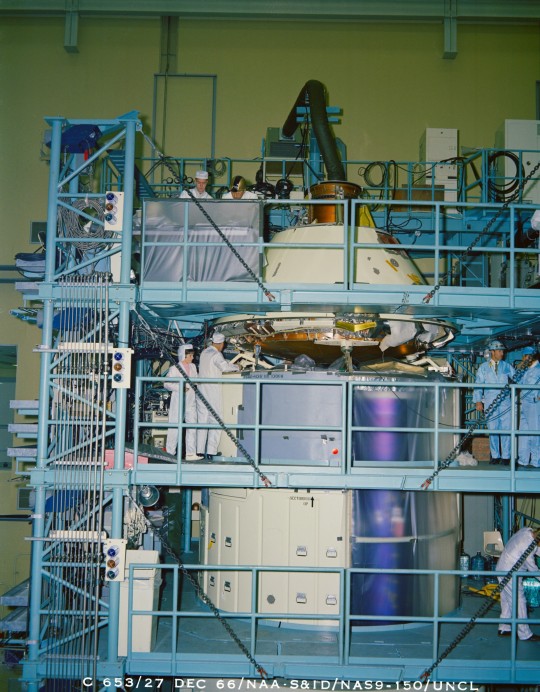
An Apollo Block I Command Module (CM) being mated to a Service Module (SM) at North American Aviation's Downey facility. Based on the date, this most likely Apollo 6's CSM, so it is SM-017 and CM-020. This reason the mismatched CM and SM was due to available hardware. SM-020 was used for Apollo 4 after its SM, SM-017, was damaged in an explosion and had to be scrapped. CM-014 was unavailable for flight as it was being used to aid the Apollo 1 investigation.
Date: December 27, 1966
NASA ID: S67-15721
#Apollo 6#Apollo CSM Block I#CSM-020#NASA#Apollo Program#A-type Mission#Construction#North American Aviation#Downey#California#December#1966#my post
32 notes
·
View notes
Text

Apollo 6 Command Module (CM-20) being mated to its new Service Module (SM-014) at North American Aviation's Downey facility. SM-020 was used on Apollo 4, since SM-017 was destroyed in a propellant tank explosion during ground testing. SM-014's Command Module (CM-014) was disassembled as part of the Apollo 1 investigation.
Date: November 29, 1966
NASA ID: S66-69044
#Apollo 6#Apollo CSM Block I#CSM-020#NASA#Apollo Program#A-type Mission#Construction#North American Aviation#Downey#California#November#1966#my post
38 notes
·
View notes
Text
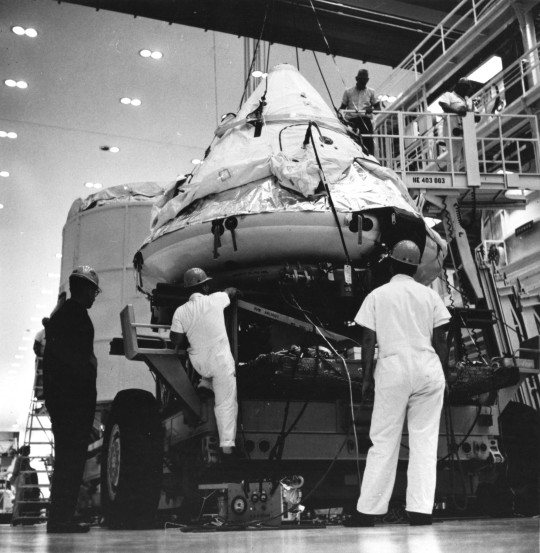

Apollo 6 Command Module (CM-020) is hoisted into position for mating with Service Module (SM-014) in the Manned Spacecraft Operations Building at the Kennedy Space Center.
Date: December 6, 1967
NASA ID: 68-H-210, S68-17301
#Apollo 6#Apollo CSM Block I#CSM-020#NASA#Apollo Program#A-type Mission#Manned Spacecraft Operations Building#MSOB#Kennedy Space Center#KSC#Florida#December#1967#my post
45 notes
·
View notes
Text
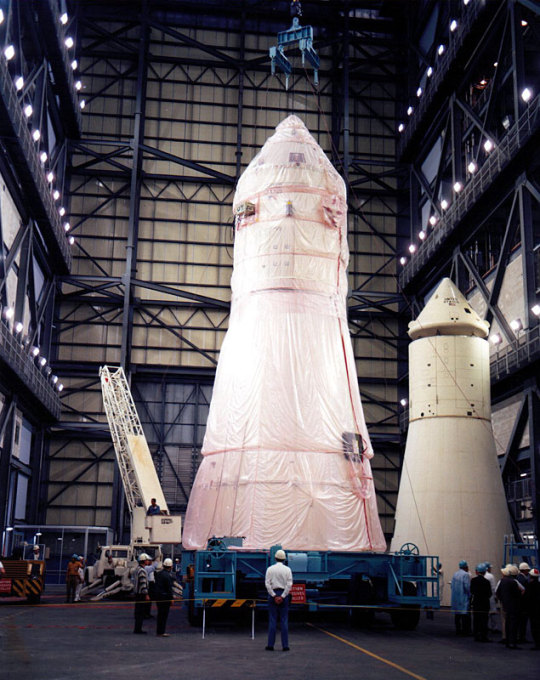
Apollo 6 Spacecraft (CSM-020/LTA-2R/SLA-9) in the transfer aisle of the VAB. In the background is the AS-500-F Facility Verification Spacecraft (M-11).
Date: December 29, 1967
NASA ID: 67-HC-825
#Apollo 6#Apollo CSM Block I#CSM-020#Lunar Module Test Article#LTA-2R#NASA#Apollo Program#A-type Mission#M-11#Stacking#Vertical Assembly Building#VAB#Kennedy Space Center#KSC#Florida#December#1967#my post
29 notes
·
View notes
Text

The launch of the Apollo 6 (CSM-020/SA-502) unmanned space mission occurred at 07:00:01.5 (EST). "The five F-1 engines of the huge Apollo/Saturn V space vehicle's first (S-IC) stage leave a gigantic trail of flame in the sky above the Kennedy Space Center seconds after liftoff."
"For the first two minutes, the Saturn V launch vehicle behaved normally. Then, as the Saturn V's S-IC first stage burned, pogo oscillations shook the vehicle. The thrust variations caused the Saturn V to experience a g-force of ±0.6 g (5.9 m/s2), though it had only been designed for a maximum of 0.25 g (2.5 m/s2). The vehicle suffered no damage, other than the loss of one of the panels of the Spacecraft-Lunar Module Adapter (SLA).
NASA Associate Administrator for Manned Space Flight George Mueller explained the cause to a congressional hearing:
Pogo arises fundamentally because you have thrust fluctuations in the engines. Those are normal characteristics of engines. All engines have what you might call noise in their output because the combustion is not quite uniform, so you have this fluctuation in thrust of the first stage as a normal characteristic of all engine burning.
Now, in turn, the engine is fed through a pipe that takes the fuel out of the tanks and feeds it into the engine. That pipe's length is something like an organ pipe so it has a certain resonance frequency of its own and it really turns out that it will oscillate just like an organ pipe does.
The structure of the vehicle is much like a tuning fork, so if you strike it right, it will oscillate up and down longitudinally. In a gross sense it is the interaction between the various frequencies that causes the vehicle to oscillate."
Photographed from a chase plane.
Date: April 4, 1968
NASA ID: 68-2736
source
#Apollo 6#Apollo CSM Block I#CSM-020#Lunar Module Test Article#LTA-2R#SLA-9#Saturn V#SA-502#Rocket#NASA#Apollo Program#A-type Mission#Launch#April#1968#my post
94 notes
·
View notes